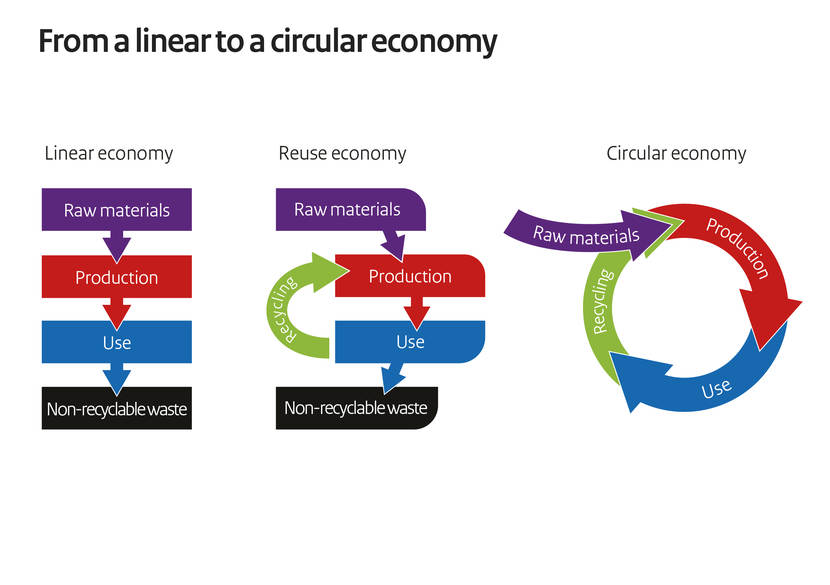The circular economy concept
Circular economy has as main objective to preserve as long as possible the value of products, components and materials within the economic system. In this way, it is oriented to achieve more efficient production and consumption systems, thanks to continuous and regenerative cycles. Thus, it allows to reduce raw materials and energy consumption, waste and emissions generation in the production processes.
The adoption of the circular economy requires a change of business, territorial and individual visions, and to rethink the way of producing and consuming. In Europe, only 5% of the original value of materials and energy used is exploited. This demonstrates the need to implement circular economics strategies, above all because of the limited availability of resources.
In this context, the European Commission Circular Economy Package promotes circular economy strategies in a transversal manner, with the ultimate goal of strengthening the competitiveness and resilience of the European economy.

The challenge of the SAWYER project:
Shifting the current linear economy into a more sustainable & circular economy is a challenge for the whole society to preserve the stock of natural resources for next generations and for increasing competitiveness, innovation, health and jobs. However, it also poses challenges such as skills, safety, business models and consumers’ behaviour.
On the 2nd of December 2015, the EC presented a new Circular Economy Package. The package contains an action plan for the circular economy, mapping out a series of actions planned for the coming years, as well as four legislative proposals on waste, containing targets for landfill, reuse and recycling, to be met by 2030.
There is no doubt that the Circular Economy Package will contribute to and facilitate the transition of the industry and the furniture sector toward a more sustainable and circular economy. However, this legislative package will not be the only driver of change toward the industry sustainability and circularity and possibly, it will be neither the most influential nor important for the evolution of furniture companies. The transition of the industry toward a more sustainable and circular economy will be the result of the implementation of a combination of legislative instruments and voluntary instruments, among which the most relevant for the furniture sector will be:
Legislative instruments:
- Circular Economy Package
- EPR schemes
- REACH regulation
- Ecodesign Directive
- WEEE & RoHS Directives
- End-of-waste criteria
- Flame retardants
- Renewable Energy Directive
- EU Industry policy for forestry
- The Blueprint for FB-industries
- Formaldehyde emissions
- The Timber Regulation or EUTR
Voluntary instruments:
- Green Public Procurement
- Environmental Management Systems in organizations
- Ecodesign
- Ecolabels
- Chain of custody
- Green building certification
- Cascading use of wood
- Bio-economy strategy
Possible benefits of an higher level of Circular Economy in the EU Furniture Sector are: 160,000 extra jobs; 3.3-5.7 mt of additional reused/recycled materials; 3.3-5.7 mt of CO2 eq. avoided and €4.9b increase in EU GVA (Source: Circular Economy Opportunities in the Furniture Sector – European Environmental Bureau).
A growing circularity is affecting all sectors, including the Furniture one. The challenge ahead is for the furniture industry to seize fully and swiftly sustainability and circularity opportunities. In this framework, there is a clear need to study and forecast the impact of the above-mentioned legislative and voluntary instruments in the next ten years, meaning, forecasting in a holistic manner how a more sustainable and circular economy will affect and transform the EU furniture sector.
Sustainability and circularity drivers will therefore impact on the organization of work (new technologies for the production process; new market opportunities; new skills needs, etc.) and the working conditions (additional new training; adapted health and safety conditions, etc.), as well as new business models and new ways of production. This is essential to ensure industry’s mid and long-term competitiveness with implications for workers and their safety. There is a need to increase the knowledge in this field to support social dialogue.
